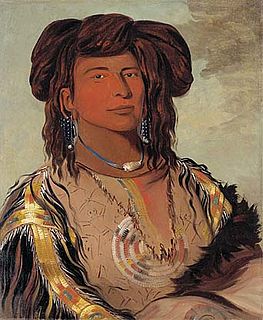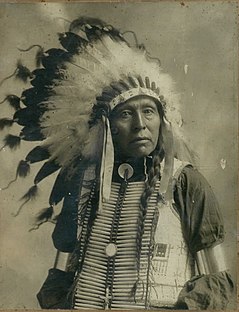Related Research Articles

The Battle of the Little Bighorn, known to the Lakota and other Plains Indians as the Battle of the Greasy Grass, and also commonly referred to as Custer's Last Stand, was an armed engagement between combined forces of the Lakota Sioux, Northern Cheyenne, and Arapaho tribes and the 7th Cavalry Regiment of the United States Army. The battle, which resulted in the defeat of U.S. forces, was the most significant action of the Great Sioux War of 1876. It took place on June 25–26, 1876, along the Little Bighorn River in the Crow Indian Reservation in southeastern Montana Territory.

The Ghost Dance was a ceremony incorporated into numerous Native American belief systems. According to the teachings of the Northern Paiute spiritual leader Wovoka, proper practice of the dance would reunite the living with spirits of the dead, bring the spirits to fight on their behalf, end American westward expansion, and bring peace, prosperity, and unity to Native American peoples throughout the region.

The Wounded Knee Massacre, also known as the Battle of Wounded Knee, was a massacre of nearly three hundred Lakota people by soldiers of the United States Army. It occurred on December 29, 1890, near Wounded Knee Creek on the Lakota Pine Ridge Indian Reservation in South Dakota, following a botched attempt to disarm the Lakota camp. The previous day, a detachment of the U.S. 7th Cavalry Regiment commanded by Major Samuel M. Whitside approached Spotted Elk's band of Miniconjou Lakota and 38 Hunkpapa Lakota near Porcupine Butte and escorted them 5 miles (8.0 km) westward to Wounded Knee Creek, where they made camp. The remainder of the 7th Cavalry Regiment, led by Colonel James W. Forsyth, arrived and surrounded the encampment. The regiment was supported by a battery of four Hotchkiss mountain guns. They were responding to concerns of the settlers who were worried the Ghost Dance might be a prelude to an armed attack.

Red Cloud was one of the most important leaders of the Oglala Lakota from 1868 to 1909. He was one of the most capable Native American opponents whom the United States Army faced in the western territories. He defeated the United States during Red Cloud's War, which was a fight over control of the Powder River Country in northeastern Wyoming and southern Montana. The largest action of the war was the Fetterman Fight, with 81 US soldiers killed; it was the worst military defeat suffered by the US Army on the Great Plains until the Battle of the Little Bighorn 10 years later.

Bury My Heart at Wounded Knee: An Indian History of the American West is a 1970 non-fiction book by American writer Dee Brown that covers the history of Native Americans in the American West in the late nineteenth century. The book expresses details of the history of American expansionism from a point of view that is critical of its effects on the Native Americans. Brown describes Native Americans' displacement through forced relocations and years of warfare waged by the United States federal government. The government's dealings are portrayed as a continuing effort to destroy the culture, religion, and way of life of Native American peoples. Helen Hunt Jackson's 1881 book A Century of Dishonor is often considered a nineteenth-century precursor to Dee Brown's book.

Crazy Horse was a Lakota war leader of the Oglala band in the 19th century. He took up arms against the United States federal government to fight against encroachment by white American settlers on Native American territory and to preserve the traditional way of life of the Lakota people. His participation in several famous battles of the Black Hills War on the northern Great Plains, among them the Fetterman Fight in 1866, in which he acted as a decoy, and the Battle of the Little Bighorn in 1876, in which he led a war party to victory, earned him great respect from both his enemies and his own people.

The Sioux Wars were a series of conflicts between the United States and various subgroups of the Sioux people which occurred in the later half of the 19th century. The earliest conflict came in 1854 when a fight broke out at Fort Laramie in Wyoming, when Sioux warriors killed 31 American soldiers in the Grattan Massacre, and the final came in 1890 during the Ghost Dance War.

The Ghost Dance War was the military reaction of the United States government against the spread of the Ghost Dance movement on Lakota Sioux reservations in 1890 and 1891. Lakota Sioux reservations were occupied by the US Army, causing fear, confusion, and resistance among the Lakota. It resulted in the Wounded Knee Massacre wherein the 7th Cavalry killed over 250 Lakota, primarily unarmed women, children, and elders, at Wounded Knee on December 29, 1890. The end of the Ghost Dance War is usually dated January 15, 1891, when Lakota Ghost-Dancing leader Kicking Bear decided to meet with US officials. However, the US Government continued to use the threat of violence to suppress the Ghost Dance at Lakota reservations Pine Ridge, Rosebud, Cheyenne River, and Standing Rock.

The Miniconjou are a Native American people constituting a subdivision of the Lakota people, who formerly inhabited an area in western present-day South Dakota from the Black Hills in to the Platte River. The contemporary population lives mostly in west-central South Dakota. Perhaps the most famous Miniconjou chief was Touch the Clouds.

Young-Man-Afraid-of-His-Horses [Tȟašúŋke Kȟokípȟapi], also translated as His-Horses-Are-Afraid and They-Fear-Even-His-Horses, was a chief of the Oglala Sioux. Commonly misinterpreted, his name means They fear his horse or His horse is feared, meaning that the bearer of the name was so feared in battle that even the sight of his horse would inspire fear. He is known for his participation in Red Cloud's War, as a negotiator for the Sioux Nation after the Wounded Knee Massacre, and for serving on delegations to Washington, D.C.

Ghost shirts are shirts, or other clothing items, worn by members of the Ghost Dance religion, and thought to be imbued with spiritual powers. The religion was founded by Wovoka, a Northern Paiute Native American, in the late nineteenth century and quickly spread throughout the plains tribes.

Lone Horn, also called One Horn (1790 –1877), born in present-day South Dakota, was chief of the Wakpokinyan band of the Minneconjou Lakota.
Black MoonWi Sapa was a Miniconjou Lakota headman with the northern Lakota during the nineteenth century, not to be confused with the Hunkpapa leader by the same name.

Spotted Elk, was a chief of the Miniconjou, Lakota Sioux. He was a son of Miniconjou chief Lone Horn and became a chief upon his father's death. He was a highly renowned chief with skills in war and negotiations. A United States Army soldier, at Fort Bennett, coined the nickname Big Foot – not to be confused with Oglala Big Foot.

Dewey Beard or Wasú Máza was a Minneconjou Lakota who fought in the Battle of Little Bighorn as a teenager. After George Armstrong Custer's defeat, Wasu Maza followed Sitting Bull into exile in Canada and then back to South Dakota where he lived on the Cheyenne River Indian Reservation.

Flying Hawk was an Oglala Lakota warrior, historian, educator and philosopher. Flying Hawk's life chronicles the history of the Oglala Lakota people through the 19th and early 20th centuries, as he fought to deflect the worst effects of white rule; educate his people and preserve sacred Oglala Lakota land and heritage. Chief Flying Hawk was a combatant in Red Cloud's War and in nearly all of the fights with the U.S. Army during the Great Sioux War of 1876. He fought alongside his first cousin Crazy Horse and his brothers Kicking Bear and Black Fox II in the Battle of the Little Big Horn in 1876, and was present at the death of Crazy Horse in 1877 and the Wounded Knee Massacre of 1890. Chief Flying Hawk was one of the five warrior cousins who sacrificed blood and flesh for Crazy Horse at the Last Sun Dance of 1877. Chief Flying Hawk was the author of his commentaries and accounts of the Battle of the Little Big Horn, Crazy Horse and the Wounded Knee Massacre, and of Native American warriors and statesmen from who fought to protect their families, defend the invasion of their lands and preserve their culture. Chief Flying Hawk was probably the longest standing Wild Wester, traveling for over 30 years throughout the United States and Europe from about 1898 to about 1930. Chief Flying Hawk was an educator and believed public education was essential to preserve Lakota culture. He frequently visited public schools for presentations. Chief Flying Hawk leaves a legacy of Native American philosophy and his winter count covers nearly 150 years of Lakota history.

The Drexel Mission Fight was an armed confrontation between Lakota warriors and the United States Army that took place on the Pine Ridge Indian Reservation in South Dakota on December 30, 1890, the day after the Wounded Knee Massacre. The fight occurred on White Clay Creek approximately 15 miles (24 km) north of Pine Ridge where Lakota were purported to have burned the Catholic Mission.

Thomas Sullivan was a United States Army soldier and a recipient of America's highest military decoration—the Medal of Honor—for his actions in the Battle of Wounded Knee, but now called the Wounded Knee Massacre.
William Horn Cloud was born in 1905, Medicine District, Pine Ridge, Potato Creek, South Dakota and died in 1992. He was born to Joseph Horn Cloud and Mildred Beautiful Bald Eagle. His father Joseph witnessed and survived the Wounded Knee Massacre.

Zintkála Nuni, alternatively 'Zintka Lanuni', was a Lakota Sioux woman who was a 4-month-old infant when she was found alive among the victims at the Wounded Knee Massacre.
References
- ↑ "Page 297; IS 1920-1922, vol. 02, no. 07".
- ↑ Surviving Wounded Knee: The Lakotas and the Politics of Memory. Oxford University Press. 6 January 2016. ISBN 978-0-19-024903-8.
- ↑ "Alice Horn Cloud 1873-1975 - Ancestry®". Ancestry.com .
- ↑ Page title [Usurped!]
- ↑ "Page 297; IS 1920-1922, vol. 02, no. 07".
- ↑ Surviving Wounded Knee: The Lakotas and the Politics of Memory. Oxford University Press. 6 January 2016. ISBN 978-0-19-024903-8.
- ↑ "Wounded Knee: Healing the Wounds of the Past - ICTMN.com". indiancountrytodaymedianetwork.com. Archived from the original on 2016-01-01.